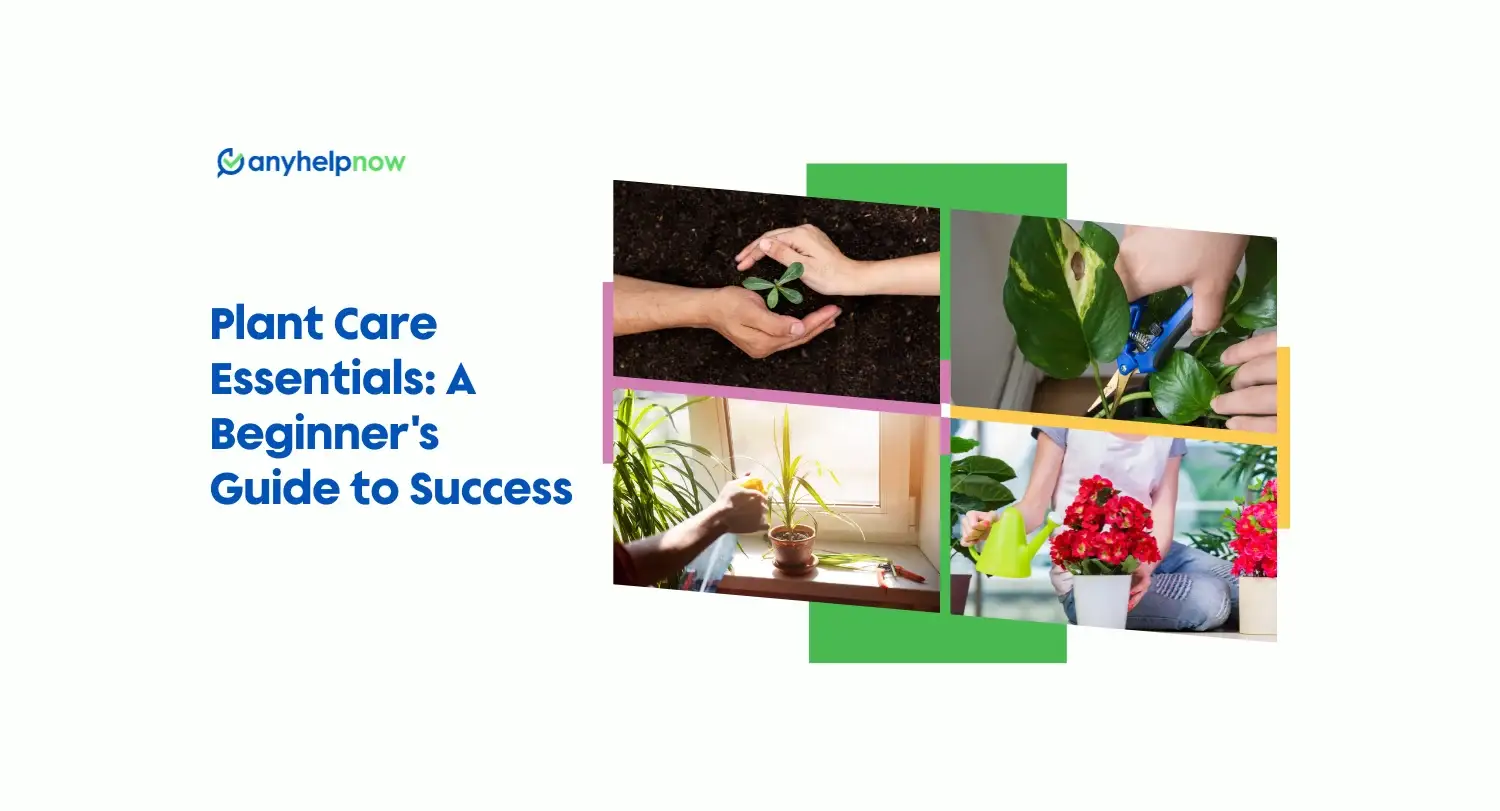Have you ever wondered how to transform your living space with the lush greenery and vibrant vitality of plants? Plant care is more than just a hobby; it's a journey towards nurturing life in your home. Whether you're a complete novice or someone who's tried and often failed to keep a plant alive, this guide is your first step toward becoming a confident plant caretaker.
Imagine your home filled with thriving, healthy plants, each adding a unique touch of nature to your space. This guide will take you through the essentials of plant care, simplifying the process and making it accessible for everyone. You'll discover the joy of watching your plants grow and flourish under your care, creating a serene and inviting environment in your home.
We'll explore everything from choosing the right plants for your living space to the secrets of proper watering, lighting, and soil management. By the end of this guide, you'll have a comprehensive understanding of what it takes to keep your plants alive and thriving. You'll gain the confidence to expand your plant collection and experiment with more challenging varieties.
So, grab your gardening gloves and dive into the world of plant care. As we embark on this green journey together, remember that each plant has its own story, and with the proper care, it can become a cherished part of your life. Read on to start your plant care journey with confidence and success!
Understanding the Basics of Plant Care
When you begin your journey into plant care, the first step is grasping the fundamentals. It's like learning a new language; understanding the basics is crucial for further mastery.
What is Plant Care?
Plant care involves providing your green friends with the right environment to grow and thrive. This includes the right amount of light, water, and nutrients. Each plant species has its own specific needs, which can vary widely. For example, succulents require less water but more sunlight, while ferns thrive in moist, low-light environments.
The Role of Plants in Home and Environment
Plants do more than just beautify our homes; they are crucial to our well-being. They're known to purify the air by absorbing toxins and producing oxygen, thus contributing to a healthier living environment. Moreover, caring for plants can be therapeutic, offering a sense of accomplishment and tranquility.
Types of Plants for Beginners
If you're new to plant care, starting with hardier varieties that are more forgiving of beginner mistakes is wise. Some great starter plants include snakes, pothos, and spiders. These plants are resilient, require minimal maintenance, and are excellent at adapting to various indoor conditions. They provide the perfect opportunity for beginners to learn and understand plant care dynamics without the discouragement of frequent failures.
Remember, the key to successful plant care is observation and adaptation. Paying close attention to plant changes will teach you much about their needs and how to respond to them. While this guide provides a foundation, authentic learning comes from hands-on experience and patience.
Fundamentals of Plant Care
Understanding the core aspects of plant care is crucial for anyone looking to cultivate a green haven at home. This section delves into the essential yet vital components of keeping plants healthy and vibrant.
Sunlight and Your Plants:
Every plant has unique sunlight needs, varying from full sun to partial shade. Knowing the light requirements of your plants is essential. Place them near windows or in spots where they can receive adequate natural light. For plants requiring less sunlight, consider locations away from direct exposure to prevent leaf burn.
Watering 101:
Watering seems simple, but it's often where most beginners stumble. The key is not just how much you water but how often. Most plants prefer a thorough watering that allows moisture to reach the roots, followed by a period of drying out. Overwatering can lead to root rot, while under-watering can cause plants to wilt and dry up. The trick lies in understanding the watering needs of each plant – some thrive with moist soil, while others need drier conditions to flourish.
The Right Soil and Fertilization:
Choosing the suitable soil is another cornerstone of plant care. Soil types range from well-draining sandy soils to moisture-retentive clay soils. Select a soil type that matches the natural habitat of your plant. Additionally, periodic fertilization is vital for providing essential nutrients. However, remember that less is more when it comes to fertilizing. Over-fertilization can damage your plants, so following recommended guidelines and schedules is necessary.
Advanced Plant Care Techniques
As you become more comfortable with the basics, it’s time to delve into advanced techniques to elevate your plant parenting skills. Advanced care is about fine-tuning your approach to meet each plant's specific needs, ensuring they survive and thrive.
Pruning and Maintenance:
Pruning isn't just about keeping plants looking neat. It's a vital part of healthy growth. For flowering plants, regular pruning encourages new blooms. In foliage plants, it helps maintain shape and promote bushier growth. The key is understanding when and how to prune each type of plant. Generally, pruning should be done during the plant's growth phase, using clean, sharp tools to avoid damaging the plant.
Pest Control and Prevention:
Pests can be a real challenge, but you can keep them at bay with preventive measures. Regularly inspecting your plants for signs of pests is crucial. Natural remedies like neem oil or insecticidal soaps can effectively treat infestations. Sometimes, a change in the plant's environment, such as adjusting humidity or light, can deter pests. Remember, prevention is always better than cure, so keep your plants healthy to make them less susceptible to pest attacks.
Seasonal Plant Care Tips:
Plants, like people, respond to seasonal changes. Understanding how to adjust your care routine with the seasons is vital. During winter, most plants enter a dormant phase requiring less watering and no fertilization. On the other hand, summer might call for more frequent watering and strategic positioning to avoid the scorching sun. Spring and fall are typical times for repotting and fertilizing, setting the stage for growth and rest phases.
Troubleshooting Common Plant Care Problems
Navigating the challenges of plant maintenance can sometimes feel overwhelming, especially for beginners. Here's a guide to help you identify and solve some typical issues you might encounter.
Yellowing Leaves and Wilting: This common problem can arise from various factors, including water stress, nutrient deficiencies, or poor lighting. First, assess your watering routine; over and under-watering can lead to yellow leaves. Ensure your plant receives the right amount of light, and consider if it's time to add nutrients or change the soil.
Overwatering vs. Underwatering: Telling the difference between these two issues is crucial for plant health. Overwatered plants often have soft, mushy leaves or stems and may show signs of root rot, such as a foul smell from the soil. Underwatered plants, on the other hand, typically have dry, crispy leaves and may droop dramatically. Check the soil moisture by feeling it a few inches below the surface; this will guide you in adjusting your watering schedule.
Dealing with Common Diseases: Fungal infections and root rot are prevalent issues. They often result from excessive moisture and poor air circulation. If you notice moldy soil and discolored or spotted leaves, it's time to act. Isolate the affected plant to prevent the spread of disease. Remove any diseased leaves and, if necessary, repot the plant in fresh, sterile soil. Ensuring good air circulation and avoiding overwatering are key preventative measures.
Beyond the Basics: Enhancing Your Plant Care Routine
Once you've mastered the fundamentals of nurturing your green friends, it's time to elevate your plant care routine. This journey is about keeping your plants alive, helping them thrive, and bringing new dimensions to your green space.
Innovative Tools and Gadgets
The world of horticulture is constantly evolving, with innovative tools designed to make plant care more efficient and enjoyable. Consider investing in intelligent pots that monitor soil moisture, or opt for self-watering systems that ensure your plants receive the right amount of water even when you're busy. Digital light meters can also be a game-changer, helping you provide the perfect amount of light for each plant species.
Community and Learning
Joining plant care communities, both online and locally, can significantly enhance your knowledge and skills. These communities offer a wealth of information, from troubleshooting specific issues to sharing the joy of new growth. Local gardening clubs and online forums are great places to connect with fellow enthusiasts, exchange tips, and stay updated on the latest in plant care.
Real-Life Inspirations
Seek out stories of individuals who have transformed their homes and lives through their passion for plants. These narratives can be incredibly inspiring, providing practical insights and creative ideas for your space. Documentaries, blogs, and social media accounts dedicated to plant care offer a glimpse into various approaches, helping you refine your methods.
Conclusion
As we wrap up our exploration into the world of nurturing plants, it's essential to recognize that plant care is a continuous learning process. Like any new skill, it requires patience, dedication, and a willingness to grow alongside your plants. The journey you've embarked upon is not just about keeping plants alive; it's about fostering a deeper connection with nature and creating a harmonious space where both you and your plants can thrive.
Throughout this guide, we've covered the critical aspects of plant care, from watering and sunlight to the complexities of pest control and seasonal adjustments. The knowledge you've gained is a solid foundation, but remember, the real learning happens in the day-to-day care of your plants. Each plant is unique, and as you tend to them, you'll learn to understand their specific needs and nuances.
One of the most beautiful aspects of plant care is its ability to mirror life cycles. There will be moments of flourishing growth and times when your plants may struggle. Embrace these as opportunities to learn and adapt. The resilience of plants can be incredibly inspiring, reminding us of our capacity to persevere through challenges.
As you continue your plant care journey, keep exploring, experimenting, and connecting with fellow plant enthusiasts. Share your experiences, celebrate your successes, and don't be disheartened by the occasional setback. Remember, every seasoned plant caretaker was once a beginner.
In closing, consider plant care a journey that evolves with time. Your plants will grow, and so will your skills and knowledge. Keep nurturing your green friends with the love and attention they deserve; they'll transform your space and spirit in return. Here's to the many rewarding experiences you'll have as you grow with your plants.


